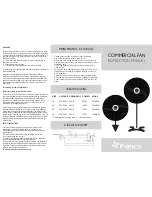
GETTING
ST
AR
TED
Balancing Airflow
Balancing the airflow verifies that the Fresh Air
Ventilation System is delivering the intended airflow
and energy performance. Use the Airflow Balancing
instructions in the Installation section to check and
balance the airflow.
Controls
Remote Override Switch Functions On/Off Control
If continuous ventilation is not required, an on/off
control can be used to activate the ventilator when it is
switched to Standby. Controls that can be used for this
function include dehumidistats, timers, wall switches
and the ventilate function of the VisionPRO IAQ and
TrueIAQ digital controls.
Dehumidistat
If moisture control in bathrooms is a primary function
of the system, a dehumidistat can be used to switch
the ventilator from a Low or Standby setting to the High
setting. Moisture removal throughout the entire home
can only be achieved when the outside air contains
less moisture than the inside air (typically during cold
weather conditions).
An HRV will override a call from the dehumidistat if
the outdoor temperatures exceed 60°F (15.6°C) for
a 24-hour period. The dehumidistat function will be
re-enabled if the unit is unplugged for 3 minutes or if
the outdoor temperature drops below 60°F (15.6°C)
for a 24-hour period. The dehumidistat function is
permanently enabled in ERVs.
IAQ Controls
The VisionPRO IAQ and TrueIAQ controls can
automatically control the ventilator by pressing the
Ventilate button on the control. See the control owner’s
guide for complete instructions.
Digital Fan Timer
The ventilator controls are compatible with the Digital
Fan Timer. If more than one timer is activated, each
runs independently with the ventilator running at high
speed until all timers have timed out. Up to eight timers
can be installed in a system.
Moisture Control
When a building is new, there is excess moisture in
the wood, plaster, cement and other construction
materials. When the new building is occupied, the
activities of the occupants also increase the moisture
level. There can also be high levels of formaldehyde
and other chemicals that were used in the building
materials. Running the ventilation system on high
speed provides optimum indoor air pollutant reduction.
High speed also provides maximum moisture removal
when the outside air contains less moisture than the
inside air. (Typically during cold weather conditions.)
Operating Damper Frost Control
Some models have an electronically-controlled damper
frost control mechanism to prevent frost buildup on the
core. Defrost timing will change based on incoming
outdoor air temperature.
Outdoor Temperauture Defrost Timer*
27 °F (-3 °C)
3 minute defrost/25 minute run
-4 °F (-20 °C)
4.5 minute defrost/17 minute run
-31 °F (-35 °C)
7 minute defrost/15 minute run
* The R2000 jumper on the control board can be
removed to meet R2000 program requirements.
Example:
When the outside temperature drops below
27 °F
(-3 °C),
the defrost timer is activated. At the end of the
25 minute run cycle, when the core can experience
some nominal frost buildup, the timer activates a
motor-driven damper door that simultaneously opens
the defrost port and closes off the supply air port.
HR150, 200; ER150, 200 Perfect Window™ Fresh Air Ventilation Systems 68-0171—12
9












































